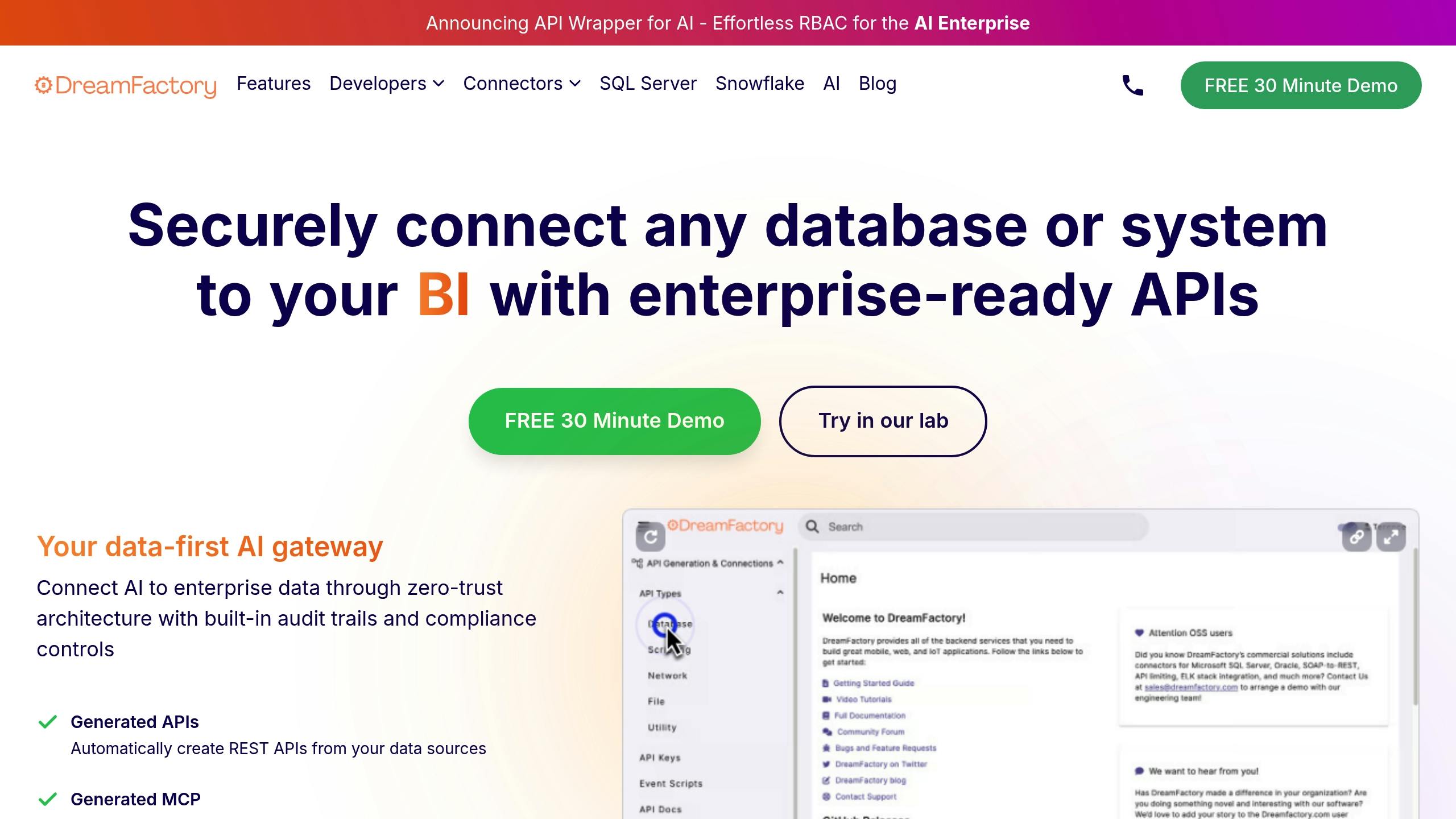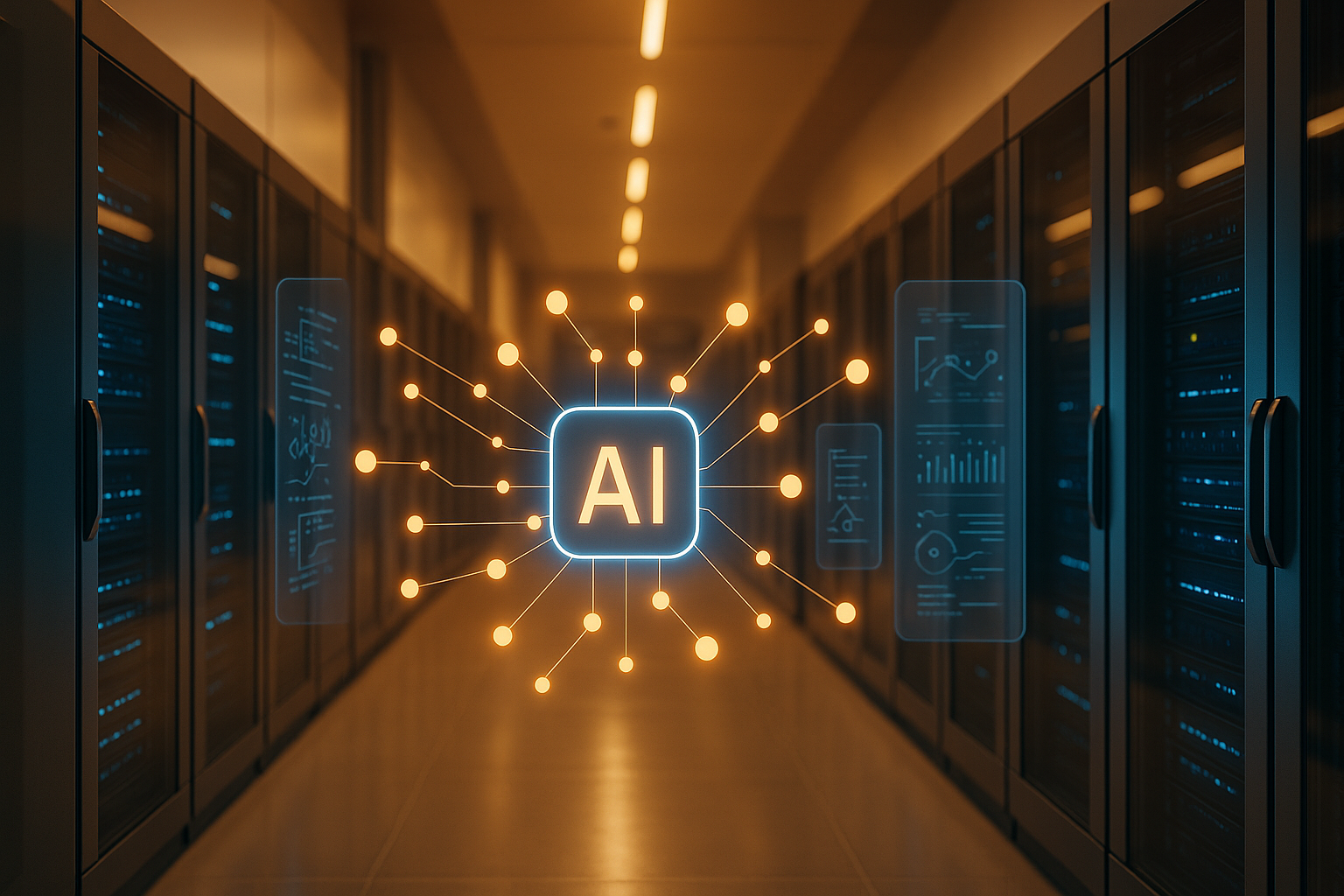Data AI Gateways are reshaping how businesses manage APIs by automating key processes like creation, security, and scaling. These platforms simplify API operations, reduce costs, and improve efficiency, making them essential for enterprises navigating AI adoption. Here's what you need to know:
What They Do: Automatically generate APIs, enforce security (e.g., RBAC), and integrate multiple databases.
Why They Matter: Tackle challenges like siloed systems, scaling, and AI governance. They also cut costs by up to 40% and improve API performance.
Key Trends:
Edge AI: Real-time, localized processing for faster decisions.
Generative AI: Automates API documentation, testing, and security.
Scalability: Handles growing data and IoT demands with event-driven architectures.
DreamFactory leads the way with tools for instant API generation, built-in security, and hybrid deployment options. As AI investment grows, adopting efficient API strategies will be critical for staying competitive.
Navigating the Future of API and AI Gateways, with Buu Lam
Key Trends Shaping Data AI Gateways Through 2030
Building on earlier discussions of automated API generation, three major trends are set to reshape Data AI Gateways by 2030. These advancements are redefining how businesses process data, manage APIs, and scale their operations to meet rising demands.
Edge AI and Real-Time Processing
Edge AI is moving toward real-time, localized processing, fundamentally changing how Data AI Gateways handle immediate data needs. By 2030, the Edge AI market is expected to hit $8.91 billion, growing at an impressive 28.8% CAGR.
This shift is fueled by industries like autonomous vehicles, healthcare, manufacturing, and agriculture, which demand real-time intelligence. Centralized systems often fall short in delivering the instant analytics and decision-making required for critical operations.
"Edge AI is making intelligence feel present - alive in ways we're just beginning to grasp. It's shifting AI from something we access to something that moves with us, anticipates needs, and creates new opportunities across industries."
To keep up, Data AI Gateways are integrating specialized processors designed to handle localized processing where network connectivity is limited or latency is a concern. This evolution ensures that gateways can operate efficiently in environments with constrained resources.
By 2030, Edge AI is projected to reach 9 billion shipments, achieving a 31% penetration rate and growing at a 25.4% CAGR. Revenue from Edge AI devices is expected to exceed $100 billion, claiming 55% of the overall AI market.
Real-world success stories highlight this trend. For example, P&O Ferrymasters improved load efficiency by 10% using AI-driven, real-time tracking and automated decision-making. This showcases how Data AI Gateways equipped with edge processing can deliver measurable business benefits through localized intelligence.
This move toward real-time processing is also setting the stage for more automated API management.
Generative AI in API Management
Generative AI is revolutionizing API management by automating tasks that once required significant manual effort, such as creating documentation and automating test cases.
The adoption of generative AI tools is accelerating. For instance, AI-related API traffic on Postman increased by 73% last year, and 54% of respondents in Postman's "2024 State of API Report" reported using ChatGPT. This growth underscores how developers are embracing AI to streamline API workflows.
Data AI Gateways are leveraging generative AI to automate key aspects of API management, including design, deployment, monitoring, and optimization. For example, AI can generate OpenAPI specifications from natural language descriptions, drastically reducing time-to-market.
Security is another area where generative AI is making strides. AI-powered anomaly detection identifies and mitigates threats in real time. The AI cybersecurity market is expected to grow from $22.4 billion in 2023 to $60.6 billion by 2028.
Generative AI is also improving API documentation by delivering clear, context-aware explanations and examples. This addresses a common developer frustration - outdated or unclear documentation that slows down integration.
Looking ahead, AI-driven tools will provide contextual suggestions to enhance API design based on usage patterns. This means Data AI Gateways will not only manage APIs more efficiently but also learn and adapt to optimize them over time.
While generative AI is refining API workflows, the rapid growth of data and connected devices is creating new scalability challenges.
Scalability and Handling Data Growth
The surge in data volumes and IoT devices is pushing Data AI Gateways to evolve their scalability strategies. With 93% of organizations recognizing APIs as essential and 97% emphasizing the integration of APIs and microservices, the pressure to manage massive workloads is immense.
To meet these demands, Data AI Gateways are enhancing performance and optimizing resource allocation. Decisions around cloud versus on-premises hosting are becoming increasingly important, as infrastructure choices directly impact scalability.
|
Scaling Approach |
Method |
Best For |
Scalability Limit |
|---|---|---|---|
|
Add more servers |
Variable traffic, stateless apps |
Nearly unlimited |
|
|
Vertical Scaling |
Increase server capacity |
Memory-heavy workloads, databases |
Hardware constraints |
|
Asynchronous communication |
High-volume, distributed systems |
Depends on implementation |
The smart home market exemplifies this growth, with a CAGR of about 40% in both revenue and units shipped. This expansion is driving Data AI Gateways to support increasingly complex, distributed systems capable of managing millions of connected devices.
Event-driven architecture is emerging as a key solution for API scalability and resilience. Unlike traditional synchronous systems, event-driven models allow for loose coupling and independent scaling of services, making them ideal for unpredictable traffic patterns.
Security remains a top priority as systems scale. In recent years, 60% of organizations have faced API-related security incidents. To address this, Data AI Gateways are adopting zero-trust security models and advanced authentication methods to protect APIs without compromising performance.
"Much like a great UI is designed for optimal user experience, a great API is designed for optimal consumer experience."
As we approach 2030, successful Data AI Gateways will be those that balance automation, scalability, and security to support the growing demands of modern enterprises.
The Next 5 Years of Automated API Generation
By 2030, AI-driven automation is set to break down traditional barriers in API development, drastically reducing timelines and driving greater efficiency for enterprises. This evolution promises faster processes and highly tailored solutions in API creation.
Instant API Generation and Customization
The future of API development is all about speed and adaptability. By 2026, 60% of enterprises are expected to adopt AI-powered API strategies. Automation will shrink development timelines from months to just days, eliminating the delays caused by manual coding and intricate configurations.
Platforms like DreamFactory are leading the way by prioritizing both speed and customization. Instead of relying on generic solutions, these platforms now offer detailed control over API behavior, security, and integration settings. This ensures that automatically generated APIs align with specific business needs while still leveraging the benefits of automation.
|
Challenge |
Automation Solution |
Business Impact |
|---|---|---|
|
Development Efficiency |
Instant API generation with auto-documentation |
Reduces timelines from months to days |
|
Security & Standards |
Built-in authentication and schema mapping |
Delivers consistent security and compatibility |
|
Performance |
Automated optimization and monitoring |
Effectively manages increasing API workloads |
Better Developer Experience
AI is transforming the developer experience by removing common hurdles in API development and documentation.
For instance, AI tools now auto-generate up-to-date OpenAPI specs, usage examples, and detailed guides. This reduces integration challenges and significantly boosts developer productivity. Companies using AI-driven APIs report 40% faster incident resolution and 30% higher productivity among developers. Additionally, modern platforms are introducing ChatGPT-like interfaces, enabling developers to interact with APIs using natural language commands.
DreamFactory illustrates this trend with its advanced auto-documentation features, which simplify the API lifecycle - spanning design, deployment, and eventual retirement. By automating these processes, developers can focus on creating impactful features rather than dealing with backend complexities. However, as these tools evolve, enterprises will need to address the challenges of scaling these solutions effectively.
Unlimited API Scaling for Enterprises
Managing large-scale API deployments is becoming more practical and cost-efficient than ever. AI-driven optimization and cloud-native architectures are eliminating traditional limitations on API volume and complexity. Predictive resource allocation is replacing static scaling methods, allowing enterprises to handle sudden traffic surges without manual effort or unnecessary over-provisioning. AI systems now monitor usage patterns, predict demand, and adjust infrastructure automatically to maintain performance while minimizing costs.
Event-driven architectures are also gaining traction for their ability to handle scaling challenges. Unlike traditional synchronous systems, these architectures allow services to scale independently, making them ideal for managing unpredictable traffic across thousands of APIs.
DreamFactory exemplifies this shift by enabling unlimited API creation, supporting enterprise growth without imposing restrictions on API volume or complexity. This flexibility allows businesses to scale their digital operations in line with evolving demands.
At the same time, security remains a critical concern. With API attacks increasing by 400% in 2023, platforms must adopt zero-trust security models and advanced authentication techniques that can scale alongside API usage without compromising performance.
In the coming years, the focus will shift for enterprises - from asking, "How many APIs can we support?" to "How quickly can we deploy the APIs we need?" This transition highlights the growing maturity of automated API generation technologies and their ability to support large-scale enterprise needs seamlessly.
Practical Strategies for Enterprises to Adapt
As Data AI Gateways continue to evolve, businesses must adopt actionable strategies to fully leverage their potential while ensuring security and operational efficiency. Striking the right balance between innovation and established practices is essential to safeguard critical systems while driving progress.
Optimizing Deployments with Edge and Cloud Models
Today's enterprises are shifting from solely relying on cloud deployments to adopting hybrid architectures that combine edge computing with cloud scalability. This approach reduces latency for time-sensitive applications while maintaining the flexibility to scale resources as needed.
Kubernetes has emerged as the cornerstone of these hybrid setups. By containerizing API services with tools like Docker, businesses can ensure consistent configurations across on-premises, cloud, or edge environments, minimizing the chances of configuration drift.
Linux-based environments provide the reliability and security needed for enterprise-grade API deployments. When paired with Kubernetes orchestration, they enable automated scaling, rolling updates, and self-healing capabilities, ensuring APIs remain functional even during traffic surges or hardware issues.
Edge computing is particularly beneficial for applications that demand ultra-low response times, such as under 100 milliseconds. By processing data closer to the end user, businesses can deliver real-time experiences while reducing bandwidth costs. Enterprises should carefully evaluate which APIs benefit most from edge deployment versus centralized hosting.
Platforms like DreamFactory support these hybrid deployment models, allowing businesses to position APIs where they are most effective without compromising on management capabilities or security. However, strong security measures are crucial to protect these deployment architectures.
Implementing Strong Security Protocols
As deployment models evolve, so must the security measures that protect them. With APIs now handling over 80% of web traffic, and 60% of organizations reporting API-related security incidents in recent years, robust security protocols are a non-negotiable part of any enterprise strategy.
Authentication and authorization serve as the first line of defense. Advanced protocols like OAuth 2.1, granular API key permissions, and short-lived tokens help ensure that users only access the resources they are authorized for, reducing risks from compromised credentials.
TLS 1.3 encryption should be enforced for end-to-end data protection, offering both security and improved performance.
Rate limiting and throttling are essential tools for preventing misuse. Fixed window rate limiting works well for predictable traffic, while sliding log limiting provides greater control for more variable workloads, ensuring no single user or application can overwhelm the system.
A whitelist-based approach to input validation, which only allows explicitly permitted inputs, can significantly reduce the risk of injection attacks.
Adopting a Zero Trust Architecture ensures that every request is continuously verified, assuming potential threats can emerge from any source.
Regular security audits - both automated and manual - should be conducted quarterly to identify vulnerabilities and address them proactively.
Future-Proofing Database Integrations
Once deployments and security are solidified, seamless database integration becomes the next focus. As enterprise data systems grow more complex, traditional methods like building custom connectors for each database are being replaced by more standardized and flexible approaches.
Modern connectors, such as those for Snowflake and MongoDB, provide pre-built, optimized integrations that handle data transformation and security automatically. This reduces the need for extensive custom development while maintaining high reliability and performance.
Snowflake Openflow is reshaping how businesses handle data movement for AI applications. David Libesman, SVP & GM of Data & Analytics at Workwave, highlights its importance:
"Our goal is to deliver seamless, data-driven experiences to our customers, and Snowflake Openflow is a foundational pillar to make that real."
Choosing between data virtualization and physical integration depends on the specific requirements of each use case:
|
Use Case |
Virtualization |
Physical Integration |
|---|---|---|
|
Real-time dashboards |
✅ |
❌ |
|
Complex analytics |
❌ |
✅ |
|
Source data frequently changes |
✅ |
❌ |
|
High performance at scale |
❌ |
✅ |
|
Data preparation for ML |
❌ |
✅ |
|
Federated governance |
✅ |
❌ |
AI Gateway technology enhances traditional API Gateway capabilities, offering features like billing, metering, content compliance, multi-backend routing, and performance optimization.
To ensure flexibility, businesses should build custom plugins that extend AI gateway functionality to meet specific needs. This approach allows integration layers to evolve alongside changing data architectures, making it easier to adapt to new data sources or formats without requiring major overhauls.
DreamFactory’s connector architecture exemplifies this adaptable approach, providing standardized interfaces that work across diverse database types while remaining flexible enough to accommodate emerging technologies.
New Tools and Technologies to Watch
As automation and scalability continue to shape the tech landscape, fresh tools are reshaping the world of Data AI Gateways. These emerging technologies are not just refining API management - they’re completely transforming how APIs are deployed and maintained. With the API Management market projected to hit $20.28 billion by 2030, keeping up with these advancements is more important than ever.
AI-Driven API Management Platforms
Today’s API platforms are smarter than ever, thanks to AI. They can now automate the entire API lifecycle, analyzing usage trends, predicting demand, and fine-tuning performance. For example, platforms like DreamFactory showcase how AI is changing the game with advanced features, including real-time anomaly detection to identify and neutralize security threats.
Gartner estimates that by 2028, 33% of enterprise software applications will feature autonomous AI, a sharp rise from under 1% in 2024. Even more striking, 15% of daily work decisions could soon be made autonomously. These developments are laying the groundwork for hardware advancements that will further elevate gateway performance.
Advances in Edge AI Hardware
Edge AI hardware is redefining how Data AI Gateways handle data processing. In 2023, the Edge AI market was valued at $20.45 billion, with forecasts suggesting it could soar to $269.82 billion by 2032, growing at an annual rate of 33.3%. Technologies like NPUs (Neural Processing Units) and ASICs (Application-Specific Integrated Circuits) are enabling AI computations directly on devices, reducing reliance on the cloud and boosting privacy.
According to IDC, global spending on edge computing is expected to climb to $232 billion in 2024, marking a 15.4% increase from 2023. By 2027, 65% of edge devices are expected to integrate edge AI, enabling real-time data processing for a variety of applications. These hardware innovations are paving the way for generative AI to take API automation to the next level.
Generative AI for Complete API Lifecycle Automation
Generative AI is now capable of handling the entire API lifecycle, from design and deployment to monitoring and optimization. These tools can automatically create API endpoints along with detailed documentation, saving developers significant time. On top of that, automated monitoring ensures that APIs maintain peak performance over time.
The combination of AI-powered platforms, cutting-edge edge hardware, and generative AI tools is creating a smarter, more efficient ecosystem for Data AI Gateways. By embracing these advancements, businesses can streamline API operations and maintain a strong competitive position in this rapidly evolving space.
Conclusion: Preparing for the Future of Data AI Gateways
The road ahead for enterprises is clear: adapting to modern Data AI Gateways is no longer optional. With AI investment projected to surge by 78% over the next five years, businesses that fail to embrace agile API management solutions risk falling behind.
Key Takeaways for Enterprises
The traditional methods of managing APIs simply won’t cut it in an AI-driven world. According to Gartner, by 2026, 80% of enterprises will rely on Agentic AI for their most critical operations. At the same time, McKinsey highlights that 78% of companies are already integrating "digital workers" into their workflows. This seismic shift demands a complete overhaul of how organizations approach API strategies.
"An AI gateway serves as your enterprise's command center for AI operations, fundamentally transforming how organizations manage their AI infrastructure." - Sudeep Goswami, CEO of Traefik Labs
Centralized AI Gateways offer a streamlined approach to data governance while reducing operational risks. But there's a catch: Deloitte reports that 70% of organizations need at least a year to resolve AI governance challenges. The time to act is now.
Edge AI is also driving significant advancements in real-time processing, offering faster speeds and improved data privacy. As AI models grow more versatile, enterprises must prioritize usability, customization, and security. Add to that the growing complexity of regulatory frameworks, and it’s clear that robust governance systems are no longer optional - they’re an absolute necessity.
This rapidly evolving ecosystem creates an opportunity for platforms like DreamFactory to deliver the secure, scalable, and forward-thinking API management solutions enterprises need to stay ahead.
The Role of DreamFactory

As edge AI and generative tools reshape how APIs are managed, adopting a unified gateway strategy becomes essential. DreamFactory is leading this transformation with its comprehensive suite of Data AI Gateway features designed to help businesses thrive in this new landscape.
The platform excels with tools like instant REST API generation, built-in security measures such as RBAC and OAuth, and support for more than 20 connectors - addressing the core challenges of modern API management. Its server-side scripting capabilities for Python, PHP, NodeJS, and V8JS allow for the customization needed to fully automate the API lifecycle. Additionally, auto-generated Swagger documentation and compliance features for GDPR and HIPAA ensure enterprises can meet current and future regulatory demands.
DreamFactory’s flexibility in deployment - whether through Kubernetes, Docker, or Linux - makes it an ideal fit for hybrid and multi-cloud strategies. And with Deloitte noting that fewer than 40% of the workforce currently has access to GenAI tools, platforms like DreamFactory that democratize API creation and management are set to play a pivotal role in the coming years.
With AI advancing rapidly and regulations tightening, businesses must embrace robust and adaptable API gateways. Those that act now will be well-positioned to lead the digital transformation reshaping industries worldwide.
FAQs
How will Edge AI and real-time processing shape the future of Data AI Gateways?
Edge AI and real-time processing are reshaping the landscape of Data AI Gateways by bringing faster, on-the-spot data analysis right to the source. This shift significantly cuts down on latency, reduces reliance on cloud infrastructure, and enables real-time decision-making for critical applications like autonomous vehicles, smart cities, and industrial IoT.
Processing data locally with Edge AI doesn’t just boost speed - it also strengthens security and privacy. Sensitive information stays closer to its origin, minimizing exposure risks. Additionally, this approach supports scalable solutions across various environments, giving developers and businesses the tools they need to create systems that are faster, safer, and more responsive to the demands of today’s technology-driven world.
How will Generative AI reshape API management in the next five years?
Generative AI is poised to reshape the way we approach API management. By automating tedious tasks like creating documentation and streamlining integrations, it promises to make workflows faster and more efficient. On top of that, it’s expected to fuel smarter API gateways that can adapt to complex traffic patterns, ensuring improved scalability and performance.
Security and compliance will also get a boost, as Generative AI can standardize API usage and minimize the need for constant manual monitoring. These advancements pave the way for creating secure, self-sufficient API ecosystems, giving businesses the tools they need to succeed in an increasingly AI-centric landscape.
How can businesses ensure their API operations remain scalable and secure as data and IoT demands grow?
To handle growing data volumes and the increasing demands of IoT, businesses must ensure their API operations remain both scalable and secure. A multi-layered security strategy is key to achieving this. For example, using API gateways can help regulate access, enforce security rules, and keep an eye on traffic flow. On top of that, integrating edge computing allows data to be processed closer to its source, cutting down on latency and lightening the load on central systems.
To further strengthen your approach, focus on best practices like token expiration, HTTPS enforcement, and granular access controls. These steps not only safeguard sensitive information but also keep APIs running smoothly, even as demand grows.
Kevin McGahey is an accomplished solutions engineer and product lead with expertise in API generation, microservices, and legacy system modernization, as demonstrated by his successful track record of facilitating the modernization of legacy databases for numerous public sector organizations.
























 Blog
Blog



